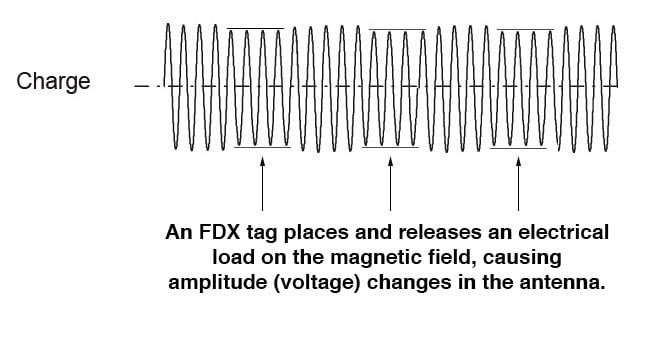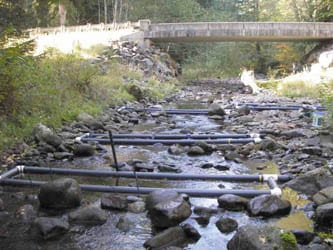Magnetic Communication
Low Frequency RFID uses magnetic fields to wirelessly power a passive tag so it can transmit an identification number. Magnetic signals can travel through most non-metallic materials, including water, wood, plastic, glass, concrete, and dirt. HF and UHF radio signals do not conduct well through water so LF RFID is the ideal choice for fish and wildlife tracking.
The ISO 11784/11785 standard specifies protocols so that tags and readers from different manufacturers will work together. FDX and HDX are interoperable but not compatible. Like AM and FM radios, there are PIT tag readers that detect FDX only, HDX only or both.
The two technologies have different strengths and capabilities so the choice depends on the how it will be used.
Half Duplex (HDX)
A half duplex RFID reader generates short magnetic pulses that wirelessly charge a capacitor inside an HDX tag. When the charge field turns off, the tag uses the stored power to send the tag number back to the reader without interference from the reader.
The capacitor in an HDX tag limits how small one can be made. Currently the smallest HDX tag is 12.0 mm x 2.15 mm.
HDX uses Frequency Shift Keying (FM) which has better noise immunity and allows larger, simpler antennas.
Antennas for HDX readers are very simple loops of insulated wire that can be placed directly in the water without an air gap or frame. Antennas for HDX can be 10 times larger than FDX ones. The largest known HDX antenna crosses a 190’/60 meter stream.
Since the charge field is pulsed, HDX readers require less power. The 50 ms/20 ms charge/listen cycle allows the scan rate of 14 per second. It is possible to shorten the charge pulse time to increase the speed up to 28 scans per second but the tag may not get fully charged.

HDX sends 1’s and 0’s on two different frequencies and is not affected by amplitude noise.

Full Duplex (FDX)
Full duplex RFID generates a continuous magnetic field which powers the tag to respond immediately. Tags repeat their message while powered by the field, up to 30 times per second.
FDX tags can be made very small and thin due to their simple construction of a coil, ferrite rod and a chip. Very small tags have short a read range and so are primarily used for proximity or hand scanning.
FDX uses Amplitude Shift Keying (AM) and is susceptible to atmospheric noise which limits antenna sizes. FDX antennas in water usually require an air gap around the wire that is held rigid to prevent movement due to vibration. Antennas are installed in large diameter plastic pipe or tubing for this purpose.


Using Both FDX and HDX
Dual mode readers can detect both kinds of tags by listening for FDX when the charge field is on and turning off every 50 ms to listen for an HDX tag. These readers must fit the requirements of both technologies so the antenna needs an air gap when placed in water and will be limited to FDX sizes.
Another possibility is to use separate FDX and HDX readers and antennas which can coexist with proper synchronization. This is more effort and cost but uses the advantages of the each technology.
